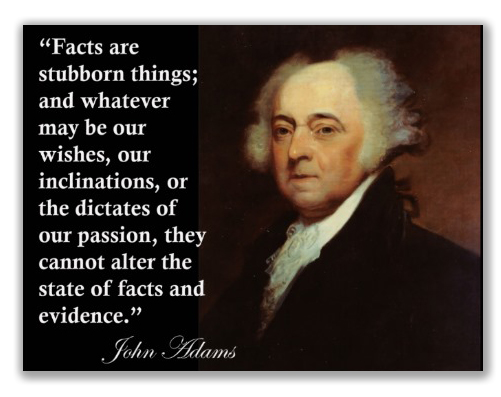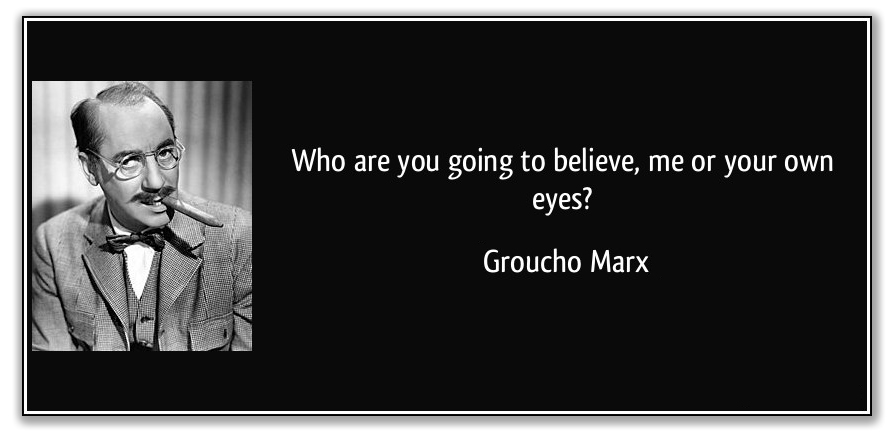We’re still doing a weekly newsletter… we’re just posting pieces of it every day. The news is fresher this way…
WHO YOU GONNA BELIEVE?
A few days ago, we reported that the success rate for post-conviction petitions in the Courts of Appeal hovers somewhere around 6%. There’s a reason for that.
Contrary to what a lot of do-it-yourself habeas corpus writ-writers clearly believe, success on a post-conviction attack on an inmate’s conviction or sentence is not pegged to how many cases you can cite in your pleading. And the number of Latin phrases you can spout ¬– while impressive to a student of the classics – is not proportional to the likelihood of winning a shorter sentence.
 Post-conviction motions are fact-driven things. If you think you’re going to prevail, you had better have a lot of facts – good facts, facts that haven’t been put in the record before – and you had better be able to stitch those into a narrative that rings the bells of the Strickland v. Washington standard.
Post-conviction motions are fact-driven things. If you think you’re going to prevail, you had better have a lot of facts – good facts, facts that haven’t been put in the record before – and you had better be able to stitch those into a narrative that rings the bells of the Strickland v. Washington standard.
There is always a special problem when a district court is judging a claim of attorney ineffectiveness, and must choose between the credibility of an already-convicted defendant whom the court will probably never see again, and the word of a well-known defense attorney who appears in front of the court all the time. Whom is it more convenient to believe, a friend you see every day or some durn stranger?
 Today’s case illustrates the point. Jose Rivera-Rivera worked for a Puerto Rican conspiracy as a drug runner, someone who supervised retail sellers’ day-to-day activities, supplied them with drugs for distribution, and collected proceeds. He was charged along with over 100 codefendants, in connection with a sprawling drug-trafficking enterprise operating in and around Ponce.
Today’s case illustrates the point. Jose Rivera-Rivera worked for a Puerto Rican conspiracy as a drug runner, someone who supervised retail sellers’ day-to-day activities, supplied them with drugs for distribution, and collected proceeds. He was charged along with over 100 codefendants, in connection with a sprawling drug-trafficking enterprise operating in and around Ponce.
On the morning of trial, Jose – who was represented by court-appointed counsel named Raymond Esteves ¬– entered a straight-up guilty plea. Although the judge explained the benefits of the safety valve option, Jose was a stand-up guy: he refused to take it. He got a mandatory minimum 10 years.
Shortly after the sentence, Jose decided that “stand up” wasn’t all it was cracked up to be. He had his lawyer tell the court he wanted the safety valve after all, but that train had left the station. After a failed appeal, Jose filed a 28 USC 2255 claim that Ray was an ineffective attorney.
Jose said Ray never told him about a 9-year plea offer made by the government. The 2255 went to a hearing, and the tales were in conflict.
Jose said he had always been willing to plead guilty because he knew the government had a strong case. But, he claimed, his communications with lawyer Ray had been so bad that the attorney had never told him about a 9-year plea offer the government made in law in March 2010. Jose said later he showed up in court for what he thought was a pretrial hearing only to find out it was the trial, something else Raymond never told him. Because he felt completely unprepared, Jose said, he entered a straight-up plea then and there.
Ray had a different story. “Although he could not remember many of the details about the petitioner’s case given the passage of years between the dates of the critical events and the date of the evidentiary hearing,” the Court of Appeals said, “he recalled that he had discussed the 9-year plea offer with the petitioner” at least six times.” Ray was pretty foggy on the details, so the district court let him rely on his CJA voucher (which he had submitted to get paid for representing Jose) to refresh his recollection.
 Unsurprisingly, the lawyer said he encouraged Jose to take the deal, but Jose insisted on seeking a more favorable offer or going to trial. Ray could not remember if he had passed the 9-year plea offer on to Jose before the deadline, but he said he urged Jose to consider it even after the deadline because he thought there would still be a chance to get the same terms. The CJA voucher corroborated that some of telephone calls Ray said he made were indeed made, and one entry specifically noted that Ray and Jose had discussed a plea offer.
Unsurprisingly, the lawyer said he encouraged Jose to take the deal, but Jose insisted on seeking a more favorable offer or going to trial. Ray could not remember if he had passed the 9-year plea offer on to Jose before the deadline, but he said he urged Jose to consider it even after the deadline because he thought there would still be a chance to get the same terms. The CJA voucher corroborated that some of telephone calls Ray said he made were indeed made, and one entry specifically noted that Ray and Jose had discussed a plea offer.
The voucher also noted that the day after the government made the 9-year plea offer in writing, Ray made several telephone calls to Jose’s house. The next communication noted in the voucher (a telephone call on March 23, 2009) indicated that Ray spoke to Jose about “a plea offer.”
After the 2255 hearing, the district court found lawyer Ray’s version of events to be generally “consistent and credible,” and denied the 2255.
Everyone knows that “a party challenging a trial court’s factual findings faces a steep uphill climb.” The climb becomes an ascent of Mt. Everest when “the challenged findings hinge on the trier’s credibility determinations,” to which a reviewing court must afford great deference.

Last week, the 1st Circuit unsurprisingly upheld the district court’s findings. “We have made it pellucid,” the Court said, “that when the fact finder chooses between two plausible but competing views of the evidence, the fact finder’s choice cannot be clearly erroneous.” Here, the district court was confronted with two diametrically opposed accounts. The judge saw and heard the witnesses, “and rested his decision on a determination that [Ray’s] version of the salient events was more credible than [Jose’s] version. The record, considered as a whole, provides adequate support for the judge’s appraisal.”
The Court of Appeals suggested it was close: “Although the attorney was unable to recall some details concerning his handling of the petitioner’s case, he was able to pinpoint several important contacts… The record further supports [the attorney’s] version of events because it shows contemporaneous court filings and CJA voucher entries referencing plea negotiations… The conclusion suggested by the court filings is reinforced by the CJA voucher, which also references plea negotiations at various points. Those entries, made long before the petitioner brought his section 2255 motion, add weight to [the attorney’s] version of events.”
The appellate panel found it “troubling that [the lawyer] had so blurred a memory of his communications with [Jose]. But several years had passed between the critical events and the evidentiary hearing, and Jose’s testimony, like the attorney’s testimony, was not a model of precision. Moreover, it is difficult to square Jose’s claim that he never knew of any plea offer with either the court filings or the CJA voucher.”
Applying the “deferential standard of review,” the Circuit honored the “judge’s choice between imperfect alternatives.” The Court said, “The judge heard conflicting testimony and made a reasonable (though not inevitable) determination regarding credibility. On this scrambled record, there is no principled way in which we can find that determination to be clearly erroneous.”
The moral is that a 2255 petitioner should know what everything in the record says before he or she files. As John Adams once said, “Facts are stubborn things.” Don’t rely on your memory where there’s a better source.
Rivera-Rivera v. United States, Case No. 15-1921 (1st Cir., Dec. 23, 2016)

